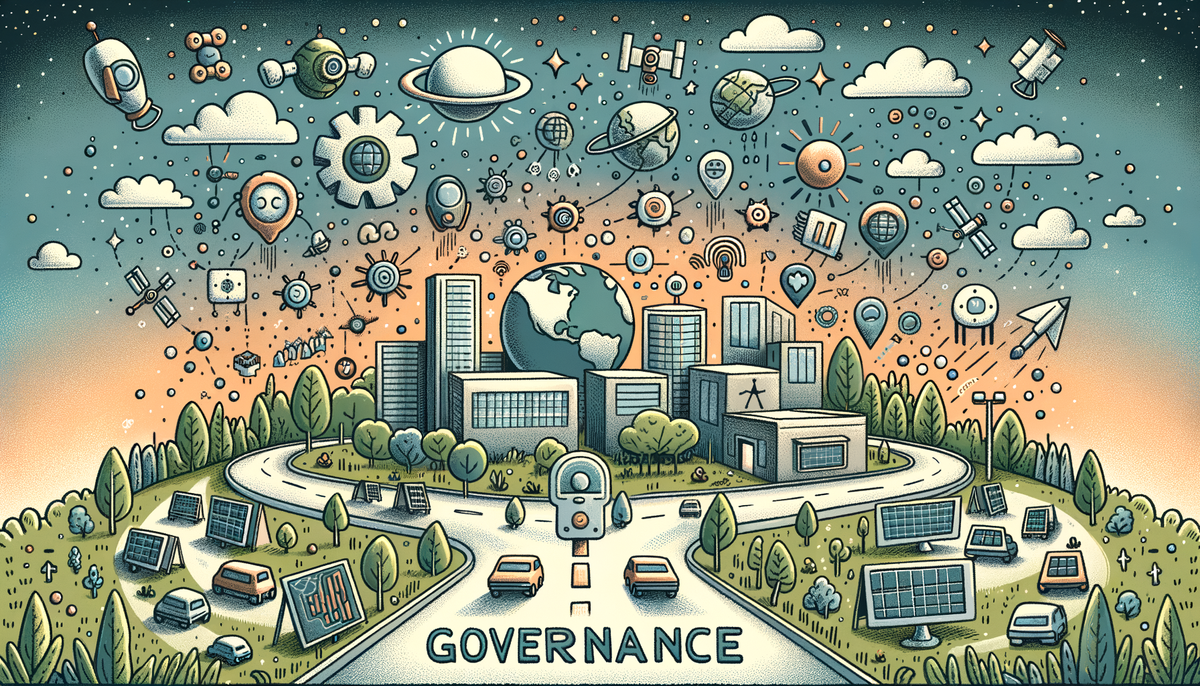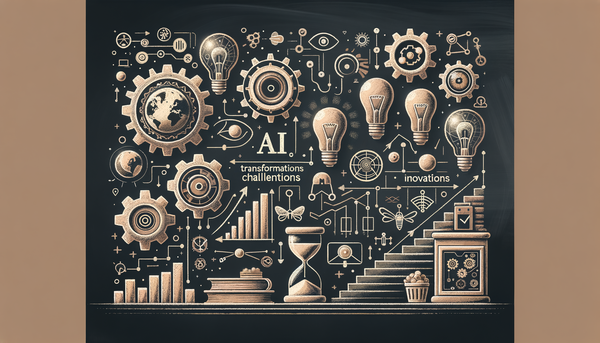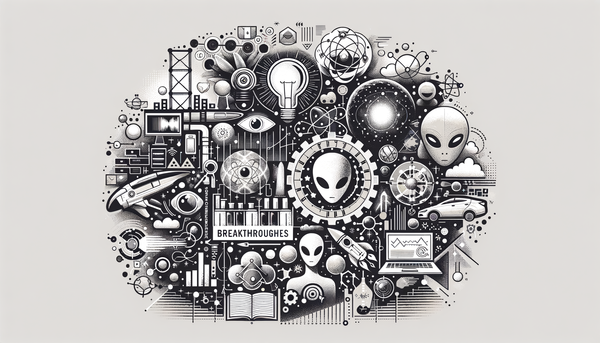MWC 2025: The Landscape of AI Innovation

A Deep Dive into the Multifaceted World of Artificial Intelligence: From Sustainable Data Centers to Revolutionary Consumer Devices and Strategic Business Innovations
This article explores diverse breakthroughs and trends in artificial intelligence across sectors—examining sustainable AI infrastructure powered by renewable energy, nuanced impacts on financial markets, transformative visual intelligence in smartphones, growth in managed security services, pioneering AI in recruitment tech, global tech unveilings at MWC 2025, and strategies that convert data into actionable insights. Together, these developments not only illuminate current progress but also hint at future implications.
Clean Energy Meets AI: The Emergence of Sustainable Infrastructure
In a time when sustainability is not just a buzzword but a necessity, the idea of using wind and solar power to drive AI data centers captures both the imagination and the potential of green technology. The discussion around Crusoe’s wind and solar-powered AI data centers suggests that such pioneering models could be ready to step onto the stock market via an IPO. This development is deeply compelling because it fuses renewable energy innovations with the rising demand for efficient and environmentally responsible data processing.
The integration of renewable energy into the backbone of AI infrastructure signifies a strategic pivot for tech companies aiming to reduce operational emissions while maximizing computational efficiency. With data centers being key drivers of energy consumption, moving towards sustainable power sources not only reduces carbon footprints but also reassures investors and regulators who are concerned about environmental impact.
This powerful convergence of green energy and cutting-edge AI might also signal a broader trend. Imagine data centers nestled in locations where wind and solar conditions are optimal, transforming isolated renewable power resources into a reliable foundation for AI computations. The reliability and scalability of renewable energy coupled with advancements in energy storage and smart grid technology can pave the way for an operational model that is as sustainable as it is innovative.
Integrating renewable energy strategies within the digital infrastructure offers a glimpse of a future where companies not only pursue profit but also commit to environmental stewardship. The prospect of these data centers eventually leading to an IPO further underscores the market’s growing confidence in sustainable tech, hinting at a new era where financial success and environmental responsibility go hand in hand.
For those interested in understanding how sustainability converges with tech innovation, exploring insights at What If Generative AI Could Help Save The Environment? can provide a broader context about the increasing role of AI in environmental advancements.
AI's Subtle Economic Footprint: Challenging Conventional Notions on Job Displacement
While discussions about artificial intelligence in the media often lead to fears of massive layoffs and disruptive job losses, a recent perspective from an article titled "AI isn't driving Wall Street layoffs. Its impact will be more subtle" from American Banker offers an alternative view. Instead of causing instant and dramatic employment shifts, AI is gradually transforming the nature of work on Wall Street and, by extension, the broader financial sector.
This nuanced narrative focuses on the idea that AI systems are increasingly embedded within the financial ecosystem—optimizing processes, identifying anomalies, and augmenting human decision-making rather than simply replacing human roles. For example, advanced algorithms can sift through mountains of market data to spot trends or risks that might go unnoticed by human analysts, thereby enhancing precision and efficiency.
The subtle impacts of AI in finance are akin to a gentle yet consistent tide reshaping the landscape. Rather than precipitating abrupt job cuts, AI enables a realignment of skills and responsibilities. This evolution facilitates a more strategic division of labor where the human elements—such as nuanced judgment and ethical considerations—complement the computational strengths of machines.
It is important to consider historical shifts in technology: during past industrial revolutions, technological innovations often led to job transformations rather than outright replacements. In the world of high finance, wherein decisions require meticulous detail and strategic thinking, artificial intelligence becomes an assistant, insight generator, and safeguard rather than a job terminator.
This sector's experience with AI shows that technology and workforce evolution can harmonize to drive productivity and innovation. Moreover, by focusing on subtle transformations rather than headline-grabbing layoffs, this approach provides a stabilizing counterpoint to more alarmist predictions, assuring industry professionals that the transition will be more evolutionary than revolutionary.
The Next-Gen iPhone: Leveraging Visual Intelligence to Enhance User Experience
The integration of AI into consumer electronics continues to redefine how we interact with technology on a daily basis. Recent advancements highlighted in ZDNet's coverage of the iPhone 15 Pro reveal that users now experience a remarkable boost through visual intelligence capabilities. This breakthrough marks a significant milestone in personalized user experience, where the device can analyze, comprehend, and adapt its interactions by interpreting visual data.
Visual intelligence in smartphones is not just about capturing higher resolution images; it represents a leap towards creating devices that can understand context and make smart decisions. The technology can, for instance, auto-adjust parameters based on lighting conditions, recognize landmarks for augmented reality applications, or even assist in identifying objects in real-time to provide users with relevant information.
By embedding AI-powered visual recognition directly into the device, manufacturers are enhancing both user convenience and accessibility. This opens up new avenues for applications ranging from healthcare to education, where visual context can be pivotal. Moreover, such advancements can significantly influence consumer behavior by enabling intuitive interfaces that reduce the learning curve for new users.
What makes the visual intelligence upgrade truly appealing is its potential to bridge the gap between human perception and digital environments. As smart devices become more adept at interpreting our surroundings, we find ourselves in a scenario reminiscent of the science fiction visions of the past—as if our gadgets are gradually coming to life with perceptual capabilities that once only existed in our imaginations.
For those curious about how these developments align with broader trends in consumer technology, exploring detailed discussions available at MWC 2025: The Future of AI in Our Hands can offer further insights into the transformative journey of AI-driven consumer tech.
AI and Security: Powering MSP Growth in Modern IT Landscapes
The fusion of artificial intelligence with cybersecurity is catalyzing a growth spurt among managed service providers (MSPs). According to ComputerWeekly.com's coverage on N-able, robust demand for security and AI solutions is propelling MSP growth to new heights. In today's digital landscape, where cyber threats are continually evolving, the ability to fuse advanced analytics with state-of-the-art security protocols is not just a competitive advantage—it is a necessity.
AI-enhanced security systems offer real-time threat detection, cutting down response times to unprecedented levels. These systems constantly learn from new threat patterns, ensuring that any anomalous behavior triggers immediate alerts and remediation efforts. Such proactive strategies are transforming traditional security paradigms, shifting the focus from reactive measures to strategic prevention.
Managed service providers that harness the power of AI are well-positioned to offer holistic security solutions. By leveraging advanced machine learning algorithms, MSPs can offer their clients tailored solutions that safeguard digital assets more effectively. This integration helps businesses not only protect themselves against cyber-attacks but also maintain compliance with increasingly stringent regulations.
A case in point can be seen in organizations that have successfully implemented AI-driven security frameworks. The technology can identify potential vulnerabilities, simulate attack scenarios, and even provide recommendations for best practices—thereby elevating overall cybersecurity readiness. Such platforms are becoming indispensable, especially in an era where digital threats are both sophisticated and pervasive.
The lessons here are clear: as AI continues to evolve, its application in enhancing security represents a critical operational pivot for businesses reliant on digital infrastructure. For a more comprehensive understanding of emerging technologies in this sphere, visiting cross-linked analyses such as those on Engaging with the Future of AI can provide valuable contextual insights.
Revolutionizing Recruitment: AI's Role in Shaping Staffing Technologies
Another domain where artificial intelligence is making significant inroads is the recruitment and staffing sector. Insights from Business Wire’s report on the Recruitment Tech Platform Tracker shed light on how AI is revolutionizing the traditional hiring process. By automating repetitive tasks and enhancing candidate matching through advanced algorithms, AI is redefining how companies engage with talent.
This transformation in recruitment technology helps firms sift through vast candidate pools with remarkable precision. The implementation of AI not only speeds up the hiring process but also improves its accuracy, ensuring that both employers and job seekers find the optimal match. Machine learning models analyze myriad data points—from resumes and online profiles to interview feedback—to predict candidate success and cultural fit.
Using AI in recruitment is nothing short of a paradigm shift. In a landscape often criticized for biases and inefficiencies, these intelligent systems work to level the playing field by basing decisions on data rather than subjective assessments. Moreover, AI can often detect nuances that human recruiters might overlook, providing an extra layer of scrutiny during the hiring process.
This evolution in workforce management invites us to rethink traditional hiring processes. It's illustrative of a broader movement where technology is reshaping industries by challenging established norms and introducing efficiencies that were previously unimaginable. While the human touch remains essential, AI-driven recruitment strategies offer an enhanced, data-backed approach that many businesses are rapidly adopting.
For those looking to explore further intersections between AI and workforce evolution, related discussions at What If Generative AI Could Help Save The Environment? illustrate how innovative technology is having far-reaching impacts across varying facets of modern business.
Global Stage: AI Innovations Unveiled at MWC 2025
The Mobile World Congress (MWC), an annual rendezvous for global technology leaders, has long been a crucible for emerging innovations. The recent showcase at MWC 2025 highlighted some of the most groundbreaking AI technologies, as reported by Euronews. At this global stage, companies from across the spectrum demonstrated how AI is not just a tool of the future—it is a transformative force of today.
Among the myriad of innovations unveiled, several focused on the application of AI in enhancing connectivity, optimizing mobile networks, and driving new business models. These developments promise to reshape not only mobile technology but the way data and interactions are managed on a global scale. From smart city infrastructures to revolutionary consumer devices, the convergence of AI and telecommunications is setting the stage for a more connected and intelligent world.
The impressive breadth of applications presented at MWC 2025 reinforces the notion that AI is a catalyst for cross-industry advancements. It is a realm where hardware meets software, and innovation isn’t limited by the traditional boundaries of any single sector. Many of these innovations are direct precursors to what we experienced in previous analyses, such as the exciting prospects explained in MWC 2025: The Exciting Frontier of AI Tech.
Drawing connections between global unveilings and targeted practical implementations, the discussions at MWC underscore the disruptive potential of AI. They validate the belief that when technology meets visionary thinking, the result is nothing short of transformational for industries worldwide.
From Data to Strategy: Engineering Intelligence with Vision AI
In another compelling development, CodeTogether’s Vision AI platform exemplifies how raw data can be translated into strategic business intelligence. This innovation is designed to empower companies to mine complex data sets and unearth insights that fuel smarter decision-making. The shift towards "engineering intelligence" encapsulates the journey from mere data collection to using analytics as a core strategic asset.
Vision AI enables businesses to pivot from reactive data analysis to predictive strategy formulation. By transforming intricate data into clear, actionable intelligence, companies can identify evolving trends, detect potential challenges, and innovate new solutions aligned with market demands. This capability is particularly valuable in today’s fast-paced, data-drenched business environment.
By adopting such technologies, organizations not only optimize operational efficiency but also create a competitive edge that transcends traditional boundaries. The ability to harness AI to inform strategic choices signals a new frontier where technology and executive strategy merge seamlessly.
“Technology could benefit or hurt people, so the usage of tech is the responsibility of humanity as a whole, not just the discoverer. I am a person before I'm an AI technologist.” – Fei-Fei Li, The Quest for Artificial Intelligence
This sentiment encapsulates the core of Vision AI’s promise: to empower human decision-making while ensuring that technology is wielded responsibly. As business leaders increasingly rely on engineered intelligence to drive growth and innovation, platforms like Vision AI stand at the forefront of a future where data is not just abundant, but truly empowering.
Reflections on the Diverse Impact of AI Across Sectors
Stepping back from the granular details of each breakthrough, it becomes evident that the recent developments in artificial intelligence are painting a picture of profound transition. Whether it’s rethinking the energy demands of data centers, subtly restructuring financial markets, revolutionizing smartphone capabilities, bolstering cybersecurity, redefining recruitment processes, or staging global technology unveilings, AI permeates every facet of modern society.
The narrative woven throughout these initiatives is one of continuous innovation combined with a conscientious approach to technological integration. For example, while the idea of sustainable AI data centers heralds environmental progress, the nuanced role of AI in sectors like Wall Street and recruitment highlights a balanced view that resists alarmist tendencies in favor of measured transformation.
This balanced evolution is reminiscent of the wisdom encapsulated by technology experts over the years. As one insightful voice puts it, “Artificial Intelligence never stops for lunch. The human race will lose their place at the table very soon.” Though this may sound foreboding, it reinforces the urgency with which innovators and regulators alike are adapting to a rapidly changing technological landscape.
Across industries, experience shows that technological revolutions often bring with them both challenges and opportunities. The lesson here is not to fear change but to embrace it cautiously, ensuring that as AI transforms our work, lives, and entire infrastructures, human values and ethical governance remain at the forefront of progress.
Drawing parallels to historical shifts, one might recall the dawn of the industrial era—a time when the introduction of mechanization disrupted traditional craftsmanship and necessitated new social contracts. Today, AI is creating a similarly transformative but far more digitally connected world. As we stride into the future, the emphasis is on collaboration between human creativity and machine intelligence, ensuring that this transformation brings widespread benefit rather than marginalization.
For those intrigued by the evolution of AI across these multiple dimensions, further enlightening discussions can be found in pieces like Engaging with the Future of AI, which delve into the broader socio-economic implications of these breakthroughs.




